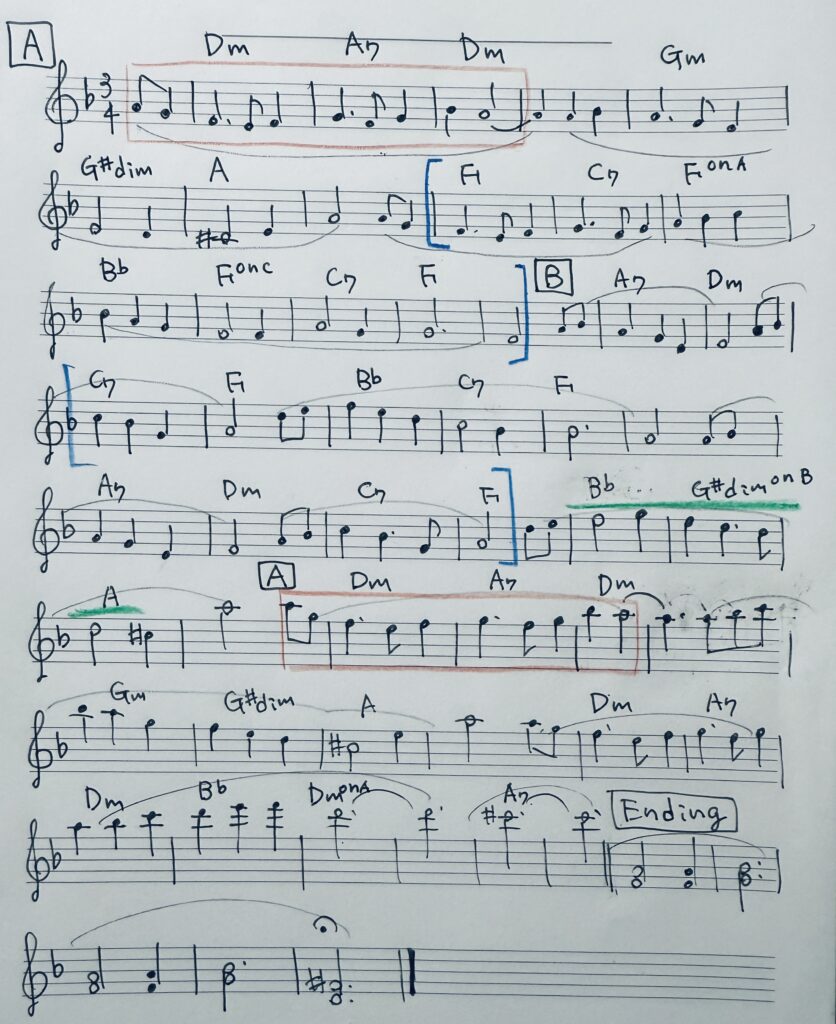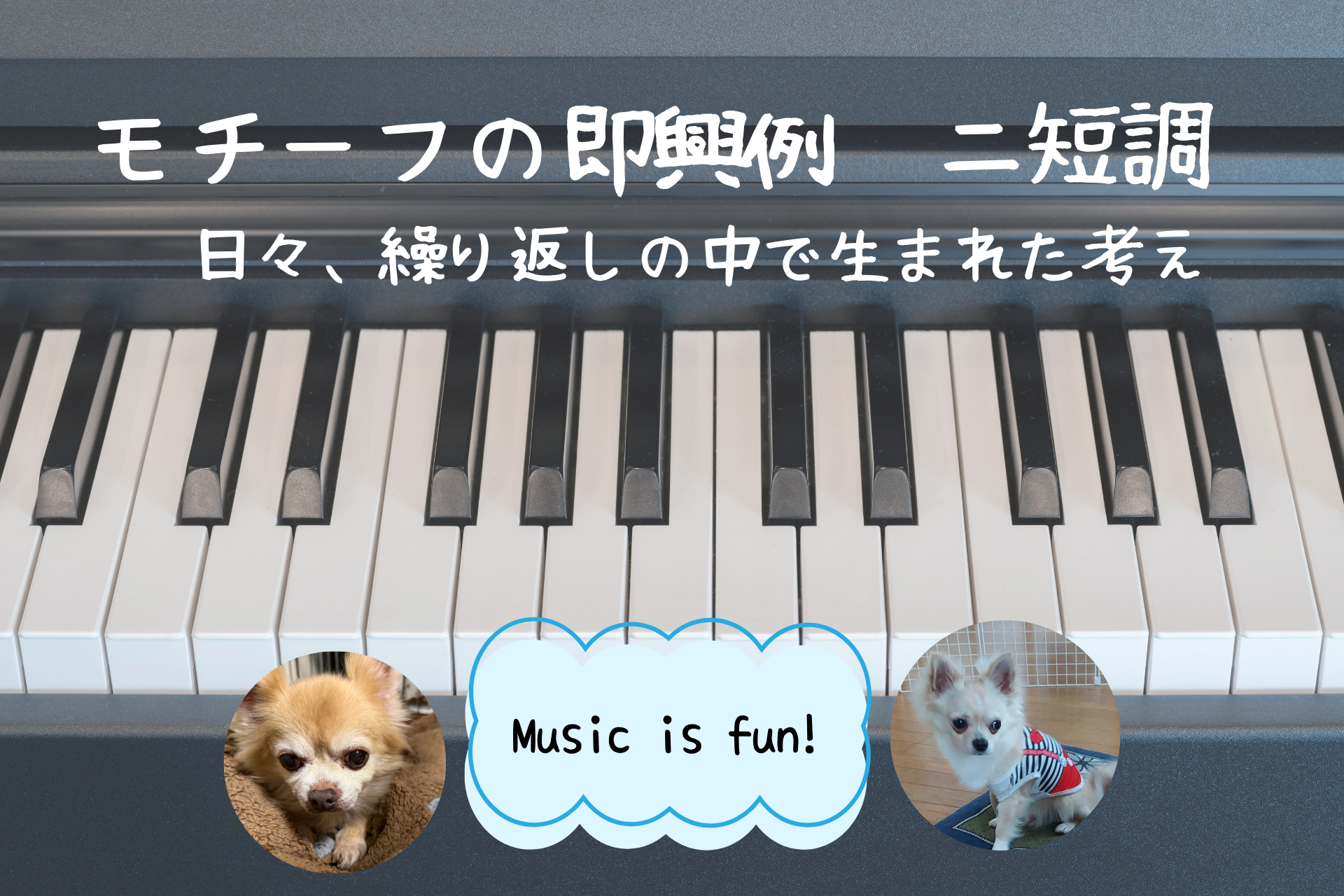モチーフの即興例〜ニ短調 / 日々、繰り返しの中で生まれた考え
今まで、いくつかのアレンジや即興をどう演奏すればいいのか、音源や動画を出してきました。
何を伝えたいのかというと、最低限の「共通言語」である「コード」
特にむずかしい和音は必要ないですが、基本的なコード進行を使って曲を作ってみることです。
モチーフ即興の例(短調)
【ピアノ即興演奏法】という本から引用して続きを作ってみました。(P87)
この課題は短調でも長調でも 良さそうですが、今回は短調 🄰 – 🄱 – 🄰の形。


ニ短調で始まり、同主調であるヘ長調のメロディーや和音を混ぜることで、曲が明るくなり変化します。
注意することはニ短調に戻るための和音を覚えておかないと、永遠にヘ長調のままになってしまうので、戻るきっかけを忘れずにね。
赤い印はモチーフ、青の印はヘ長調になったところ、緑の印はニ短調とAに戻るとても大事なコード進行です。
コード進行がどうしても思いつかない人はこのまま真似して弾いてみて。エンディングの和音も工夫してください。イントロがないので、エンディングが長くなるとバランスが取れなくなるので、適度な長さで。
最近考えていること

音楽は生(なま)、という意味と、生きるの(せい)、自分にとってどちらもです。
生きている何か。言葉であったり、姿や命。
音楽は気持ちの面がとても大きく、見えない何かが宿ることが多い(宗教的に聞こえるかもしれないけど、それとは違います)
そして、楽譜というツール。
楽譜上の記号や音符のやり取りだけでは、おもしろくないものになってしまいます。それのみをするということは、退屈な時間を過ごしたということ。
確かに情報を伝える世界共通の大切なツールではあるけれど、
それで全てが伝わるとは思っていなくて、音がただ鳴っているのか、何かが宿っているのか、聴いている人のハートを打つには後者が必要だと思います。
例えば子供に 𝑓 を説明するとしたら?
馬鹿みたいに思うかもしれないけど、私ならこう説明するかも。
ある日、イオンの屋根の上から大きな影がゆっくり見えて、
そこからのっそりと恐竜が現れて、とうとうこっちに向かって
コンクリートがひび割れしながら、どすんどすんと歩いてくる。
そうするとここでの 「𝑓 」は
恐怖、巨大、
もしこのような言葉での説明がないとしたら、
音の大きさだけを要求することになる。
もしも誰かと演奏する時、人にこの部分はこうしてと伝える時、教える時、お互いにいろんな想像力があり、言葉はなくともやりたいことがわかるような関係なら𝑓の意味を理解できますが、記号のやり取りだけでは到底納得のいく音楽はできません。
想像力がない音楽ほどつまらないものはないし、がっかりだし、何より退屈です。
人はどんなふうにその音楽を捉えているのか?
相手から出てくる言葉、経験、見えているもの、を聞くのはちょっと面白いし意外性も知ることができる。要求される側も楽しみです。
そんな感じで、人に対する尊敬や近づきたい気持ち、信頼が生まれてくる。
私はそうやって人間関係を築いています。
インスタのハイライトにはこんなのもあります

インスタのハイライトにはクッキング動画を置いてます。料理動画に見せかけて音楽を宣伝する戦略なのですが。
とはいえ、SNSは楽しみながらやりたいので、これからはオリジナルレシピも考えていきたいと思ってます。
料理の工程はきちんと手順を踏んでしなけれんば美味しいものはできないんだなと実感。
素材の選び方、素材の下処理、火を通す時間や調味料を足していく順番。
全ての工程に意味があるように、音楽も同じなんだなと思って。適当にやってもできる人は、もう手順が頭に入っているか、体感覚で覚えているか。
何もない人は適当ではダメです。基本的なことをおさえ、自然にできるまで練習。
時間がかかるけど、それは確かに価値のあるものに近づいている証拠です。
本気でやる音楽はなかなかしんどい・・というのが本音
喜びや楽しみは本当に本当に遠くにあるもの。なかなか手には入らないけれど、手に入れることができた時は、もう死んでもいいやとも思ってしまいます。
なので、生と死と音楽は、一直線上にあるものと捉えています。
これはこうだ、と説いてるわけじゃなく、その日その時期でこんな考えだったと振り返る記録。
Newアルバム、配信開始しました




コメント